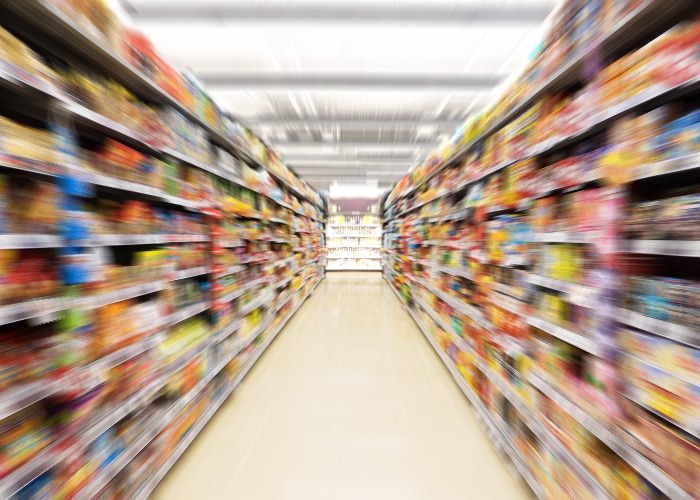
The items we buy may be getting smaller, but don't kid yourself that the price is falling too. Here's a detailed look at the biggest shrinkflation culprits.
It’s a clear sign of getting older when you bemoan the fact that chocolate bars are smaller – and pricier – than you remember them.
I mean honestly, have you seen the price of a Curly Wurly these days?
However, if you are concerned that the various items you buy as part of your regular big shop seem to be getting smaller, then you are not alone.
What is ‘shrinkflation’?
Shrinkflation is the term given for the phenomenon of getting less for your money when you shop.
While the price of the individual item that you are buying may not have changed, the actual quantity has reduced ‒ or ‘shrunk’.
The latest example has been spotted at Tesco, specifically on the pricing of Hellman’s mayonnaise.
The old 800g jars of both the ‘real’ and ‘light’ versions, which cost £3.60, have been pulled.
They have been replaced with a smaller version, which includes just 600g of mayo, and yet the price has been hiked to £3.75.
That’s just one example, but it’s by no means an isolated one.
Other cases spotted by shoppers recently include Jacobs Mini Cheddars which have grown in price by 25p and yet have become 2g smaller, while lemon case slices at Tesco have dropped from 174g to 160g yet risen in price by 10p.
The most common size-changers
A previous study by the Office for National Statistics (ONS) into the issue dug into which sorts of products are most likely to be subject to changes in size.
The ONS puts the items that it tracks the price of into various categories, and it found that the ‘bread and cereals’ category was the one that saw the largest number of changes, both in terms of shrinking and growing product sizes.
Indeed, food and drink generally dominated the study, accounting for 70% of the size reductions and 71% of the size increases.
Outside of food categories, ‘appliances and products for personal care’ (which covers things like toilet roll and tissues) and ‘non-durable household goods’ (which includes the likes of kitchen roll and washing up liquid) saw the most size increases and reductions.
It’s not just what we eat that can be subject to this practice, after all.
The chart below details which categories were found to have seen the most size changes during the term of the study, between 2015 and 2017.
Why is shrinkflation happening?
There are some key factors driving the practice of shrinkflation. Suppliers are obviously looking to get the best possible margins from their products, and trimming the amount included is a simple way to do that.
It’s not necessarily just down to being sneaky though.
Production costs for all sorts of suppliers have risen in recent years down to a combination of the energy crisis, the pandemic and Brexit.
Realising that household finances are under pressure, there is a logic to cutting product sizes rather than simply passing on the entirety of those higher costs to shoppers.
Rocketing food prices
Shrinkflation is annoying at all times, but it’s particularly painful at the moment.
That’s because the prices we have to pay for our food are rocketing at an incredible rate, even if you end up getting the same amount for the items you’re buying.
The latest data from the Office for National Statistics shows that while the overall rate of inflation currently stands at 8.7% for the 12 months to April, it’s far more pronounced on food and drink.
In fact, it’s now at 19.1%, only slightly down from March, meaning it is the second-highest rate seen since 1977.
Household budgets are under enormous pressure anyway with costs rising on so many of our regular spends, from broadband bills to Council Tax.
That our food costs are rocketing is a huge problem, let alone the fact that there’s a good chance that on at least some of the items we are buying we end up getting less than was previously the case.
What can you do about it?
The best solution to shrinkflation is to shop around regularly for your big shop.
If you compare your shopping costs – and quantities – between different supermarkets then you may be able to mitigate against the effects of shrinkflation and ensure that you still get the best possible return from the money you spend.
Even if you opt to stick with the same tried and tested supermarket, it’s worth comparing different brands to see just how much of an item you get for your money.
In some cases, your money will go a lot further just by switching to an own-brand item where there is no noticeable change in quality.
You should also keep an eye on our weekly roundup of the best supermarket deals and think carefully about how you pay.
Opting for a cashback or reward credit card may mean that you get something back when you spend on your food shopping, which can help you save some cash elsewhere.
Finally, don’t ignore supermarkets’ own loyalty schemes.
Generally, these schemes offer you some sort of points reward when you spend with them, which can be cashed in for money off vouchers either with the supermarket or elsewhere.
However, it’s become increasingly common for supermarkets to offer lower prices on specific items to members of their loyalty scheme, offering another way to cut the cost of your food shop.